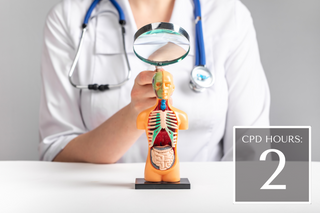

-
Overview
While well-known systems like the sympathetic nervous system are widely understood, doctors may be less familiar with the more recently identified endocannabinoid system (ECS).1,2 The ECS is thought to be involved in regulating pain, immunity, stress, appetite, weight, and nausea, yet it remains largely absent from traditional medical education in Australia.3
What will you learn?
This module aims to equip you with the skills and confidence to integrate medical cannabis into patient care when clinically appropriate. Drawing on current evidence and theoretical case studies, the module explores the ECS, cannabinoid pharmacology, proposed therapeutic effects, and the clinical implications of both ECS function and use of medical cannabis.Through interactive scenarios and evidence summaries, you’ll explore how this knowledge may be relevant to clinical applications—ranging from the potential involvement of the ECS in patient presentations to identifying possible treatment approaches.
Estimated Duration: 2 hours
Access Duration: 12 months from date of purchase
Learning Outcomes
Upon completion of this module, you’ll be able to:
- Identify the ECS's components, role and functions, as currently understood
- Relate the ECS's functions to the potential therapeutic effects of medical cannabis
- Describe the limitations and uncertainties in the current evidence relating to the ECS, and how this may affect clinical decision-making
References
- Harvard Health Publishing. The endocannabinoid system: Essential and mysterious. https://www.health.harvard.edu/blog/the-endocannabinoid-system-essential-and-mysterious-202108112569 (accessed Aug 2025).
- Parliament of Australia. Current barriers to patient access to medicinal cannabis in Australia. https://parlinfo.aph.gov.au/parlInfo/download/committees/reportsen/024403/toc_pdf/CurrentbarrierstopatientaccesstomedicinalcannabisinAustralia.pdf (accessed Aug 2025).
- Hillard CJ. Circulating Endocannabinoids: From Whence Do They Come and Where are They Going? Neuropsychopharmacology. 2018;43:155–172.
Overview
While well-known systems like the sympathetic nervous system are widely understood, doctors may be less familiar with the more recently identified endocannabinoid system (ECS).1,2 The ECS is thought to be involved in regulating pain, immunity, stress, appetite, weight, and nausea, yet it remains largely absent from traditional medical education in Australia.3
What will you learn?
This module aims to equip you with the skills and confidence to integrate medical cannabis into patient care when clinically appropriate. Drawing on current evidence and theoretical case studies, the module explores the ECS, cannabinoid pharmacology, proposed therapeutic effects, and the clinical implications of both ECS function and use of medical cannabis.
Through interactive scenarios and evidence summaries, you’ll explore how this knowledge may be relevant to clinical applications—ranging from the potential involvement of the ECS in patient presentations to identifying possible treatment approaches.
Estimated Duration: 2 hours
Access Duration: 12 months from date of purchase
Learning Outcomes
Upon completion of this module, you’ll be able to:
- Identify the ECS's components, role and functions, as currently understood
- Relate the ECS's functions to the potential therapeutic effects of medical cannabis
- Describe the limitations and uncertainties in the current evidence relating to the ECS, and how this may affect clinical decision-making
References
- Harvard Health Publishing. The endocannabinoid system: Essential and mysterious. https://www.health.harvard.edu/blog/the-endocannabinoid-system-essential-and-mysterious-202108112569 (accessed Aug 2025).
- Parliament of Australia. Current barriers to patient access to medicinal cannabis in Australia. https://parlinfo.aph.gov.au/parlInfo/download/committees/reportsen/024403/toc_pdf/CurrentbarrierstopatientaccesstomedicinalcannabisinAustralia.pdf (accessed Aug 2025).
- Hillard CJ. Circulating Endocannabinoids: From Whence Do They Come and Where are They Going? Neuropsychopharmacology. 2018;43:155–172.
